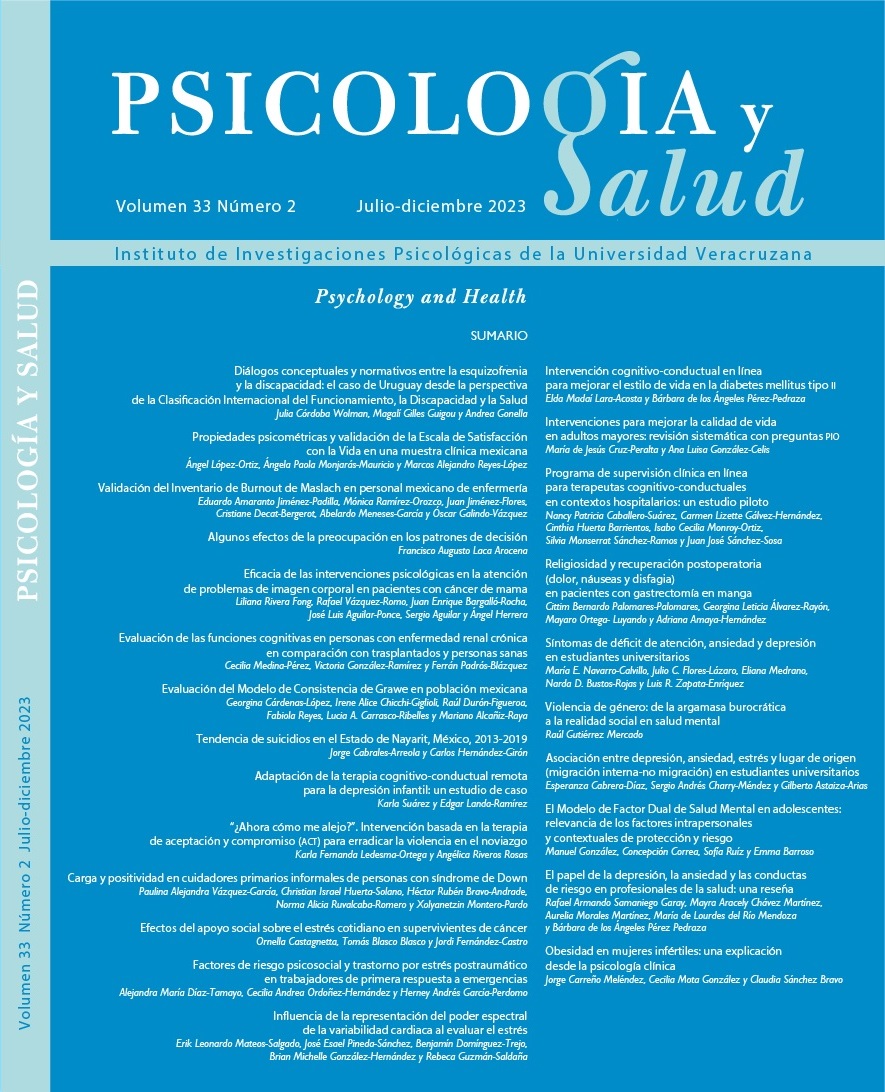Abstract
Worry is a cognitive process anticipating the possible consequences of a situation that affects decision-making processes beyond its adaptive function of alertness and balance of own resources to cope with situations. Early research on worry focuses on its most common causes and frequency. More recently, some studies examined people's explanations to justify high levels of worry despite the high costs involved. From this second perspec-tive, in this study, we analyze worry and its relationship with decision-making patterns in a Mexican sample (N= 116; 66 males, 50 females). We also compare the scores of the Mexican sample in decision-making patterns with those of the members of other cultures, Anglo-Saxon and Asian.
References
Alzate, R., Laca F., A. y Valencia J., F. (2004). Decision making patterns, conflict styles, and self-esteem. Psicothema, 16(1), 110-116.
Bandura, A. (1986). Social foundations of thought and action: A social cognitive theory. Englewood Cliffs, NJ: Prentice-Hall.
Bauman, Z. (2007). Miedo líquido. La sociedad contemporánea y sus temores. Barcelona: Paidós.
Beattie, J., Baron, J., Hershey, J.C. y Spranca, M.D. (1994). Psychological determinants of decision attitude. Journal of Behavioral Decision Making, 7, 129-144.
Beck, U. (2007). Teoría de la sociedad del riesgo. En J. Beriain (Comp.): Las consecuencias perversas de la modernidad (pp. 123-154). Barcelona: Anthropos.
Brown, T.A., O’Leary, T.A. y Barlow, D.H. (1992). Generalized anxiety disorders. En D. H. Barlow (Ed.): Clinical handbook of psychological disorders (pp. 137-189). New York: The Guilford Press.
Eysenck, M.W. (1992). Anxiety: The cognitive perspective. Hillsdale, NJ: Erlbaum.
González, M., Bethencourt, J.M., Fumero, A. y Fernández, A. (2006). Adaptación española del cuestionario ¿Por qué preocuparse? Psicothema, 18, 313-318.
Janis, I.L. y Mann, L. (1979). Decision making. A psychological analysis of conflict, choice, and commitment. New York: The Free Press.
Kahneman, D. (2021). Pensar rápido, pensar despacio. Barcelona: Debolsillo.
Laca A., F.A. (2012). Racionalidad limitada en la sociedad del riesgo mundial. Revista de Economía Institucional, 14(26), 121-135.
Laca A., F.A. y Alzate, R. (2004). Estrategias de conflicto y patrones de decisión bajo presión de tiempo. Revista Internacional de Ciencias Sociales y Humanidades, 14(1), 11-32.
Laca A., F.A., Mejía, J.C. y Mayoral, E. (2011). Conflict communication, decisión-making, and individualism in Mexican and Spanish university studentes. Psychology Journal, 8(1), 1-15.
Lazarus, R. y Folkman, S. (1986). Estrés y procesos cognitivos. Barcelona: Martínez Roca.
Luna A., C. y Laca A., F.A. (2014). Patrones de toma de decisiones y autoconfianza en adolescentes bachilleres. Revista de Psicología, 32(1), 40-65.
Luna A., C., Laca A., F.A. y Cedillo L., I. (2012). Toma de decisiones, estilos de comunicación en el conflicto y comunicación familiar en adolescentes bachilleres. Enseñanza e Investigación en Psicología, 17(2), 295-311.
MacLeod, C. y Rutherford, E. (2004). Information-processing approaches: Assessing the selective functioning of attention, interpretation, and retrieval. En R. G. Heimberg, C. L. Turk y D. S. Mennin (Eds.): Generalized anxiety disorders: Advances in research and practice (pp. 109-142). New York: The Guilford Press.
Mann, L. (1982). Decision-Making Questionnaire. Manuscrito no publicado. Adelaide (Australia): Flinders University of South Australia.
Mann, L., Burnett, P., Radford, M. y Ford, S. (1997). The Melbourne Decision Making Questionnaire: An instrument for measuring patterns for coping with decisional conflict. Journal of Behavioral Decision Making, 10, 1-19.
Matthews, A. (1990). Why worry? The cognitive function of anxiety. Behaviour Research and Therapy, 28, 455-468.
Matthews, G. y Funke, G.J. (2006). Worry and information-processing. En G. C. L. Davey y A. Wells (Eds.): Worry and its psychological disorders: Theory, assessment, and treatment (pp. 51-67). New York: John Wiley & Sons Ltd.
Matthews, G. y Harley, T.A. (1996). Connectionist models of emotional distress and attentional bias. Cognition and Emotion, 10, 561-600.
Matthews, G. y Wells, A. (2003). Rumination, depression, and metacognition: the S-REF Model. En C. Papageorgiou y A. Wells (Eds.): Depressive rumination: Nature, theory and treatment (pp. 125-151). New York: John Wiley & Sons Ltd.
Paulos, J.A. (2019). La vida es matemática. Las ecuaciones que explican los avatares de nuestra biografía. Ciudad de México: Tusquets (Col. Metatemas).
Spielberger, C.D., Goursh, R.L. y Lushene, R.E. (2008). STAI: Cuestionario de Ansiedad Estado-Rasgo (7ª ed. rev.). Madrid: TEA.
Watkins, E. (2004). Appraisals and strategies associated with rumination and worry. Personality & Individual Differences, 37, 679-694.
Zeidner, M. (1998). Test anxiety: The state of the art. New York: Plenum Press.

